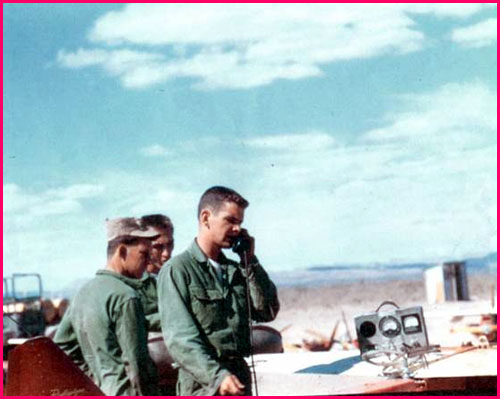
Photo courtesy MSgt Leroy Lewis
RCAT RADIO TRANSMITTERS

Photo courtesy MSgt Leroy Lewis
RCAT RADIO TRANSMITTERS
These are the radio transmitters that we used to fly the Drones. There are four of them in the picture.

Photo courtesy MSgt Leroy Lewis
CHECKING CONTROL SURFACES
This member of the launch crew is checking the control surfaces. He is talking to the controller as he stands beside the drone. He can visually verify that the control surfaces deflect in the proper direction and amount in response to the controller's commands via radio.
The OQ 19D has only Left, Right, Up, Down, and Chute. You can loop, roll and fly it upside down. I could even make it flip end over end. Most controllers who I saw try it would crash it.
I remember one day when I was in Korea, we were flying for AAA guns and we were done for the day. The Drone had plenty of gas so the crew called me and requested that I put on a show. I did. The last thing I did was to make it flip end over end. The Lt. in charge of the unit wanted to know how I did it. He was the Boss so I told him. We flew from the top of a tower. As soon as I gave him the Control box I got down out of the tower. I knew what was going to happen. It was going to crash. When it did crash the crew would look to see who was flying it. With me off the tower, when they looked they would see the Lt. not me. If they thought I crashed it, they would never let me forget. Just as I touched the bottom of the tower the plane crashed.
You might ask, why would they always crash it. Most controllers will launch the Drone, fly the mission and the bring it home. They never play with it. When they do they may have a little problem. When I was an instructor at the Drone school, I would launch the plane, give it to the student and when it was low on fuel I would land it. Any time the student got into trouble and couldn't get it out of trouble I would take over control of the plane. Most of the time when I had to take control, the plane was in a spin or heading for the ground. After a year or two I got pretty good at flying. So I would never crash it.
The controls are very touchy. You could give it a left command and hold it for a fraction of a second and the plane would be upside down.
The OQ 19B had an autopilot. You could only make a turn of 55 degrees left or right and 35 up or down. That is why we could fly it out of sight. The OQ 19D, we had to see it at all times.
Surprisingly, controllers were not required to have either FAA or Air Traffic Control (ATC) licenses.
|
|
|
|